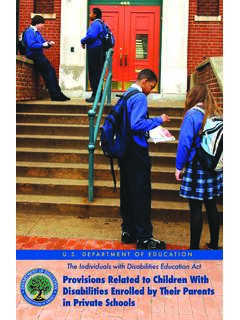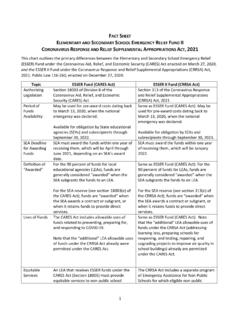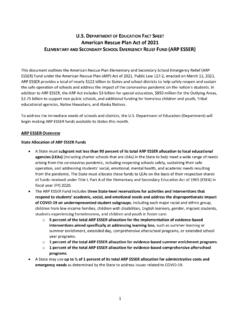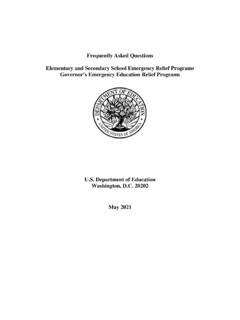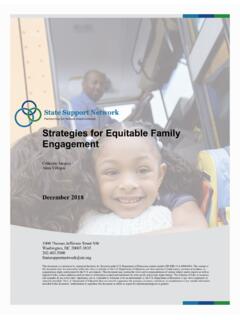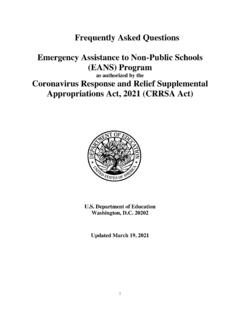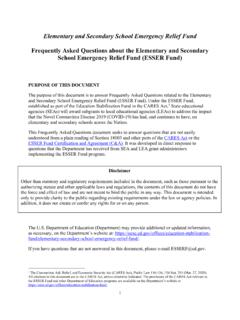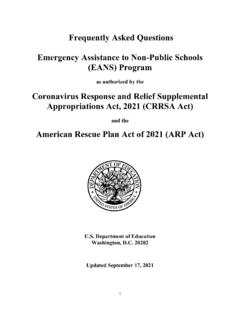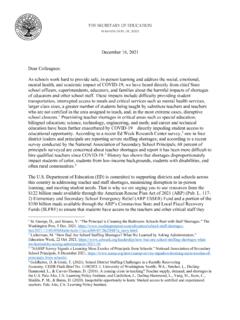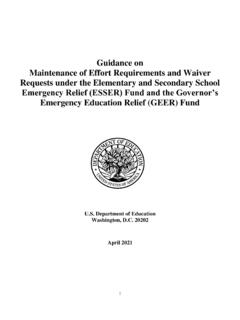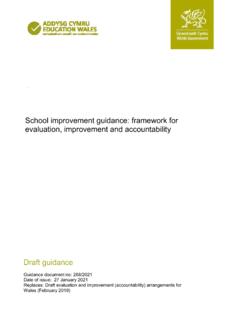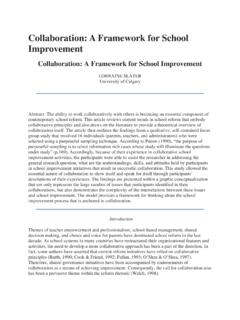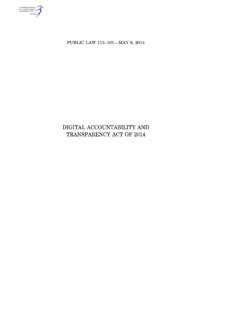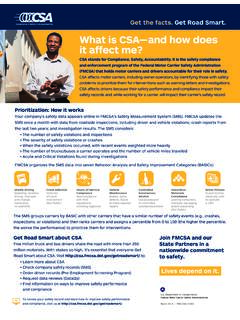Transcription of Frequently Asked Questions Impact of COVID-19 on 2021 …
1 Frequently Asked Questions Impact of COVID-19 on 2021-2022 accountability Systems Required under the Elementary and Secondary Education Act of 1965 (ESEA). Draft for Public Comment December 2021. Draft for Public Comment Table of Contents 4. A. GENERAL .. 7. A-1. What accountability and school improvement requirements apply for the 2021-2022 school year and the resulting fall 2022 accountability determinations?.. 7. A-2. If an SEA is not able to implement or would like to modify its approved ESEA consolidated State plan for the 2021-2022 school year ( , for accountability determinations in fall 2022), may a State amend its State plan? .. 7. A-3. How may an SEA submit a request to amend its ESEA consolidated State plan? .. 7. A-4. May an SEA submit both an amendment to its ESEA consolidated State plan using the regular amendment process for long-term changes, as well as an amendment using the COVID-19 State Plan Addendum to account for changes to its accountability system for the 2021-2022 school year only?
2 9. A-5. Must an SEA engage in meaningful consultation prior to submitting a request to amend its ESEA. consolidated State plan?.. 9. A-6. What opportunities for technical assistance are available from the Department to SEAs considering amending their accountability systems? .. 10. B. accountability 10. B-1. What discretion does an SEA have regarding its long-term goals and measurements of interim progress? .. 10. B-2. May an SEA amend its system of annual meaningful differentiation for the 2021-2022 school year ( , for fall 2022 accountability determinations) through the COVID-19 State Plan Addendum? .. 11. B-3. May an SEA modify its methodology for calculating its Academic Achievement indicator? .. 11. B-4. Must an SEA adjust its Academic Achievement indicator based on participation rate for assessments administered for the 2021-2022 school year? .. 12. B-5. What discretion does an SEA have regarding use of results from high school end-of-course assessments in the Academic Achievement indicator for fall 2022 accountability determinations?
3 12. B-6. May an SEA modify its Other Academic indicator for elementary and secondary schools that are not high schools? .. 12. B-7. What discretion does an SEA have related to using measures of student growth for its indicators? .. 13. B-8. What should an SEA consider regarding data quality from the 2020-2021 school year for measures of student growth? .. 13. B-9. May an SEA modify its methodology for calculating its Graduation Rate indicator? .. 14. B-10. May an SEA modify its Progress in Achieving English Language Proficiency (ELP) indicator through the COVID-19 State Plan Addendum?.. 15. B-11. May an SEA modify its School Quality or Student Success (SQSS) indicator or indicators? .. 15. 1. Draft for Public Comment B-12. What should an SEA consider when adding, replacing, or making modifications to an SQSS. indicator that measures college and career readiness? .. 15. B-13. May an SEA that uses chronic absenteeism as an SQSS indicator modify its definition of chronic absenteeism?
4 16. B-14. What may an SEA consider for use as an Other Academic or SQSS indicator? .. 17. B-15. May an SEA use indicators that are not statewide? .. 17. B-16. May an SEA revise its minimum number of students for accountability ?.. 17. B-17. How may an SEA define student membership in the economically disadvantaged subgroup in the case where it cannot use its normal methodology? .. 18. C. SCHOOL IDENTIFICATION AND EXIT .. 19. C-1. When is an SEA required to next identify schools for comprehensive support and improvement (CSI), targeted support and improvement (TSI), and additional targeted support and improvement (ATSI)? .. 19. C-2. Must an SEA identify a completely new cohort of at least the lowest-performing five percent of Title I schools for CSI based on data from the 2021-2022 school year in fall 2022? .. 19. C-3. May an SEA modify its methodology for identifying CSI, TSI, or ATSI schools? .. 19. C-4.
5 May an SEA modify its definition of a consistently underperforming subgroup for the purposes of identifying TSI schools in fall 2022 using the State Plan Addendum? .. 19. C-5. May an SEA modify the frequency by which it identifies schools, so that after identifying schools in fall 2022, it may identify schools again in fall 2023 in order to resume implementation of its approved school identification methodologies as quickly as possible? .. 20. C-6. May a school exit CSI or ATSI status in the 2021-2022 school year? .. 20. C-7. May an SEA modify its exit criteria to allow previously identified schools to exit after the 2021- 2022 school year? .. 21. C-8. May an SEA modify its exit criteria for schools identified for CSI or ATSI in fall 2022, including the State-determined number of years that the school has to meet the criteria before, for a CSI. school, it must take a more rigorous State-determined action or, for an ATSI school, it is identified for CSI?
6 21. C-9. May an SEA shift its timeline for the application of exit criteria for CSI and ATSI schools that were previously identified? .. 21. D. SCHOOL SUPPORT AND improvement .. 22. D-1. What should an LEA or identified school consider when developing or updating its CSI, TSI, or ATSI support and improvement plan? .. 22. D-2. What resources are available to support SEAs, LEAs, and schools when developing support and improvement plans? .. 23. D-3. How must SEAs, LEAs, and schools evaluate resource equity? .. 24. D-4. May an SEA consider OTL measures as described in the Department's COVID-19 Handbook, Volume 2 when determining how to award ESEA section 1003 funds to support schools with the greatest needs? .. 24. 2. Draft for Public Comment D-5. May a CSI, TSI, or ATSI school in an LEA that applied for and received ESEA section 1003. funds on behalf of the school modify how it uses the funds to address school improvement needs related to COVID-19 ( , to use funds in ways not planned for in its original application)?
7 25. D-6. What are examples of allowable uses of ESEA section 1003 school improvement funds that may address issues related to COVID-19 ? .. 25. D-7. May ESEA section 1003 funds be used to pay for current or additional school-based staff ( , instructional and non-instructional staff, mental health staff, school nurses, school counselors)? .. 26. D-8. May an SEA extend the duration of a subgrant to an LEA under section 1003 from four years to five years? .. 26. D-9. What options are available to an SEA that has unused section 1003 funds after awarding funds to its CSI, TSI, and ATSI schools in amounts that are sufficient to meet their needs? .. 27. E. STATE AND LOCAL REPORT CARDS .. 27. E-1. What information will be required for State and local report cards based on data from the 2021- 2022 school year? .. 27. E-2. May an SEA or LEA use a different report card style or format to report data from the 2021-2022.
8 School year than it used for reporting data from prior school years? .. 28. E-3. Must an SEA update the description of its accountability system to reflect changes to the accountability system for the 2021-2022 school year? .. 28. E-4. What should a State consider when reporting assessment data from the 2020-2021 school year? 29. E-5. What additional information might an SEA include on its State report card? .. 29. E-6. Have there been any changes to the requirements in ESEA section 1111(h)(1)(C)(viii) and (h)(2)(C) regarding the data that an SEA and LEA must report from the Civil Rights Data Collection (CRDC) on their school year 2021-2022 report cards? .. 30. 3. Draft for Public Comment INTRODUCTION. The Elementary and Secondary Education Act of 1965 (ESEA) requires each State to develop and implement a single, statewide accountability system to support all public elementary school and secondary school students in meeting the challenging State academic standards.
9 These systems are important tools in achieving the goal of improving outcomes for students and eliminating opportunity gaps in the State, local educational agencies (LEAs), and schools. Due to the extraordinary circumstances created by the Coronavirus Disease 2019 ( COVID-19 ). pandemic, the Department of Education (Department) invited State educational agencies (SEAs) to apply for a waiver from the accountability requirements of the ESEA for the 2019- 2020 and 2020-2021 school years and the assessment requirements for the 2019-2020 school year. As a result, many SEAs have not implemented all aspects of their statewide accountability systems or identified schools for support and improvement since fall 2019. Upon receiving an accountability waiver for the 2020-2021 school year, each SEA agreed that it would resume identifying schools for comprehensive, targeted, and additional targeted support and improvement using data from the 2021-2022 school year in the fall of 2022 to ensure school identification resumes as quickly as possible.
10 The purpose of this draft document is to support SEAs, LEAs, and schools as they implement accountability and school improvement requirements under section 1111 of the ESEA. The Department recognizes that there may be Questions as SEAs prepare to implement their systems this year. As SEAs consider changes to their accountability systems due to the Impact of COVID-19 , this is also an opportunity for SEAs to consider ways they can refine and further strengthen these systems consistent with ESEA requirements. In developing this document, the Department has sought to answer a number of the Frequently Asked Questions posed by teachers, school and LEA leaders, SEA representatives, civil rights organizations, education advocates, and policymakers. The Department is providing an opportunity for the public to comment on this draft document, as described below. As each SEA determines how best to implement its accountability system in order to continuously improve and best meet the needs of students, consistent with the requirements of the ESEA, it might consider: 1.
